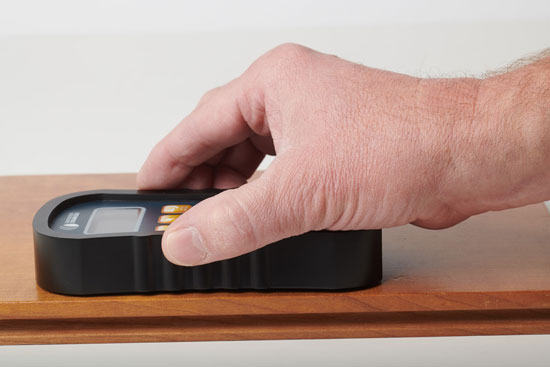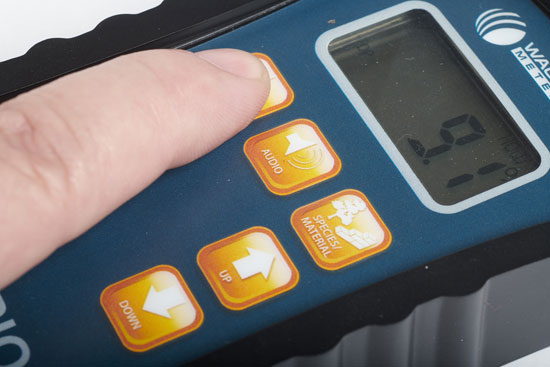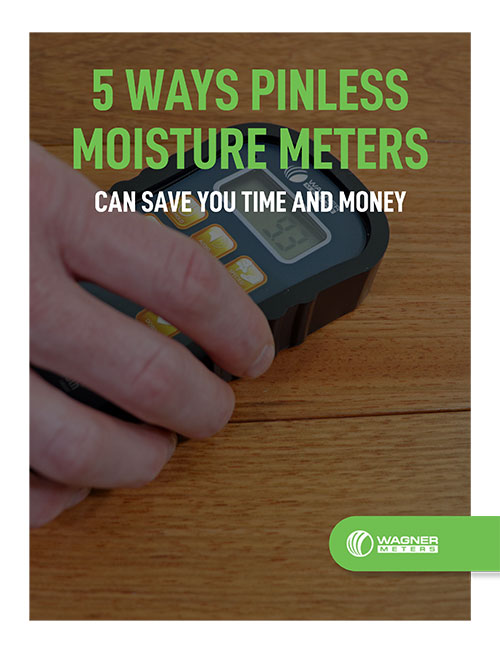Top 11 Pinless Moisture Meter Best Practices
Here are eleven best practices for using your pinless wood moisture meter. Really though, this article is chock full with a few extras here and there, so keep an eye out.
- Ensure your meter is calibrated
- Account for the wood species being measured
- Set the correct depth setting
- Take multiple readings across the surface
- Have at least a one-inch air gap underneath the wood being measured
- Only take measurements where the entire sensor plate can lay flat on the wood’s surface
- Press down on the moisture meter with the right amount of pressure
- Don’t take a reading where there is a noticeable defect or knot
- Make sure there’s no visible moisture or water on the wood’s surface
- Take good care of your meter
- Don’t ignore the manufacturer’s documentation
1. Ensure your meter is calibrated
It’s impossible to get an accurate moisture measurement with an uncalibrated tool. Some moisture meters have a built-in calibration test function. Unfortunately, these “tests” can only test a portion of the circuitry and even then, are unreliable.
The only acceptable method of verifying a wood moisture meter’s calibration is through the use of an external calibration reference of some type. The high-quality moisture meters either come with them, or they can be purchased as an option. They’re not expensive and easy to use.
More importantly, be careful not to confuse a calibration test with a recalibration functionality. Neither a built-in nor external calibration test will recalibrate the meter.
If the external calibration test shows your meter is out of calibration, you’ll have to send it back to the manufacturer to get recalibrated, unless you have an Orion moisture meter.
Orion is the only line of wood moisture meters you can recalibrate yourself in the field.
2. Account for the wood species being measured
The unique properties of each wood species affect how the moisture meter determines its readings. The density of the species affects the electromagnetic field in a pinless meter, which influences the waves and thus the meter readings.
Moisture meters have a species setting that will account for these species variations if you set it to the right species before taking a reading. Always check the species setting before starting a round of moisture content testing. If it’s set for a different species, the moisture measurements won’t be accurate.
If your moisture meter doesn’t have a species setting or its setting range doesn’t include the species being measured, check the wood species correction table that came with your meter. The correction table will tell you what the actual moisture content reading is for the species being measured, based on the moisture content percentage the meter returns.
If you are using an uncommon species, Wagner Meters has a website at www.wagnersg.com to help you find the correct species setting.
3. Set the correct depth setting if the meter has adjustable depth capabilities
 The moisture content in wood isn’t uniform. The surface dries faster than the core. Measure at varying depths to account for the moisture gradient in the wood.
The moisture content in wood isn’t uniform. The surface dries faster than the core. Measure at varying depths to account for the moisture gradient in the wood.
The depth setting on the pinless moisture meter determines how deep into the wood the plate sends out electromagnetic waves.
If you want to measure the moisture content of a board that’s half an inch thick, using a moisture meter set at a ¾” depth isn’t going to do you any good. Instead, you want to set the meter to read at ¼” depth.
Likewise, if the wood’s thickness is greater than 1.5 inches, then you need to take readings on both faces. Most pinless moisture meters have a maximum depth of 3/4 of an inch. In order to get accurate readings throughout the piece of wood, you’ll have to take moisture measurements from both sides. Otherwise, you’re only measuring the moisture in one half of the piece.
4. Take multiple readings across the surface to get a complete assessment of the wood’s moisture content
Having multiple moisture readings ensures you’re not making any decisions based on limited information. Obviously, the larger the piece of wood being measured, the more measurements you should take.
The same principle holds for measuring a stack of lumber. The more pieces you measure, the more confidence you’ll have to make decisions based on the readings you do have. There are often a couple of outliers in a stack of wood that you’ll want to make sure you exclude from your project.
5. Have at least a one-inch air gap underneath the wood being measured
You don’t want any other materials to get caught in the electromagnetic wave field from the meter. If other materials are hit by the wave, they’ll affect the reading returned. If another conductive material, like metal, is beneath the wood, it will interfere with the readings.
If another material that contains moisture is below it, say a concrete subfloor beneath wood flooring, then that moisture may get reflected in the meter reading. In the case where the wood can’t be separated from the materials below it, like in the case of a concrete subfloor, make sure the depth setting isn’t so deep that the electromagnetic waves will pass through the concrete as well as the wood.
6. Only take measurements where the entire sensor plate can lay flat on the wood’s surface
 As noted above, the electromagnetic wave sent out by the plate of the pinless meter is affected by every material it passes through. The wave is going to extend out the same dimensions as the sensor plate, which is generally between two and 2.5 inches.
As noted above, the electromagnetic wave sent out by the plate of the pinless meter is affected by every material it passes through. The wave is going to extend out the same dimensions as the sensor plate, which is generally between two and 2.5 inches.
As a result, if the plate is resting partially on material other than the wood being measured, you won’t get accurate results.
7. Press down on the moisture meter with the right amount of pressure
Each manufacturer will specify the right amount of pressure to use with its meter. You need to use the right amount of pressure to ensure that the plate is in complete contact with the surface being measured. If you don’t use enough pressure, an air pocket may be present between the sensor plate and wood.
The air pocket will interfere with the meter’s moisture reading. You’ll typically not need to apply more than three pounds of pressure on the meter to take a reliable reading.
8. Don’t take a reading where there is a noticeable defect or knot
If you’re following best practices #6 (lay sensor plate flat) and #7 (use enough pressure), you’re likely already avoiding knots and defects when taking measurements. However, the greater concern is that these spots have a higher density than the rest of the piece of wood.
Since you’re also following best practice #2 (use proper species setting on the meter), you know that the density of the wood affects how the pinless meter measures the moisture content.
The knot or defect is the outlier on the board, so taking a reading on at that location won’t provide an accurate picture of the overall moisture reading for the wood.
9. Make sure there’s no visible moisture or water on the wood’s surface
A small amount of surface moisture, such as condensation, will interfere with how moisture meters take their readings. The best practice is to wipe down the wood’s surface and then let it dry for at least 60 seconds. The more surface water you had to wipe off, the longer you should let it dry before using the meter.
Keep in mind that there’s a good likelihood that the surface has absorbed some of that moisture before you wiped away the water.
As a matter of fact, make sure there’s no surface moisture on the meter’s sensor plate either. As you would with moisture on the wood’s surface, wipe the plate down and give it some time to dry before using the meter.
There are differences in how pinless meters operate when surface moisture is present. For example, Wagner Meter’s IntelliSense™ technology only reads moisture within the wood when set at ¾” depth, so it will give you a reading that’s closer to the actual moisture content than other pinless meters… while most other meters will provide a wildly inaccurate measurement when condensation or other surface moisture is present.
10. Take good care of your meter
If you throw your meter into the back of your truck or on a pile of other tools, you’re not doing yourself any favors. If you’re throwing your meter around, you’re probably not taking other simple steps to maintain it in working order. Things like making sure it has enough battery power. Using it with low battery power can return an inaccurate reading.
Regularly check the sensor plate for any scratches or chips. Physical damage to the plate can also interfere with getting an accurate moisture content percentage.
11. Don’t ignore the manufacturer’s documentation
Moisture meter features and construction vary from manufacturer to manufacturer. Always follow the manufacturer’s specifications regarding how that meter must be used to provide the most reliable results. You’ll notice many of these best practices require some details.

How much pressure is the minimum needed for a meter? How big should the air gap below the wood be? We’ve included what are typical guidelines, but always check the owner’s guide for your moisture meter. It will have all these use specifications for you.
Some details, like how long you need to hold a certain button to run a function or get some data, can only be found in the manufacturer’s documentation.
For example, the Orion 950 will calculate the EMC point for you, but if you don’t know which buttons to push to get the EMC reading, that feature won’t do you any good.
In general, the owner’s manual and other manufacturer resources should answer most any question you have about using and maintaining your pinless moisture meter. It should also provide you with the contact information for additional support if you can’t find the answer to your question.

Free Download – 5 Ways Pinless Moisture Meters Save You Time and Money
Our bonus best practice recommendation:
12. Own a Wagner Meters pinless moisture meter!
Our extensive Orion moisture meter line has the right moisture meter for your needs. All of them use our IntelliSense technology and can be calibrated in the field.
You can select a single depth model if that fits your requirements. You can select a model with automated data collection features if you need to report and verify your findings for a general contractor.
Take a look through our Orion pinless wood moisture meter comparison chart to review all your options.
Avoiding pitfalls in moisture measurement can save you time and resources. Make sure to check out our insightful article, ‘Common Moisture Meter Mistakes,’ to learn about frequent errors and how to prevent them, enhancing your projects’ accuracy and reliability.
As Sales Manager for Wagner Meters, Ron has more than 35 years of experience with instrumentation and measurement systems in different industries. In previous positions, he has served as Regional Sales Manager, Product and Projects Manager, and Sales Manager for manufacturers involved in measurement instrumentation.
Last updated on March 12th, 2024




I would like to purchase a pinless moisture meter. Kindly advise